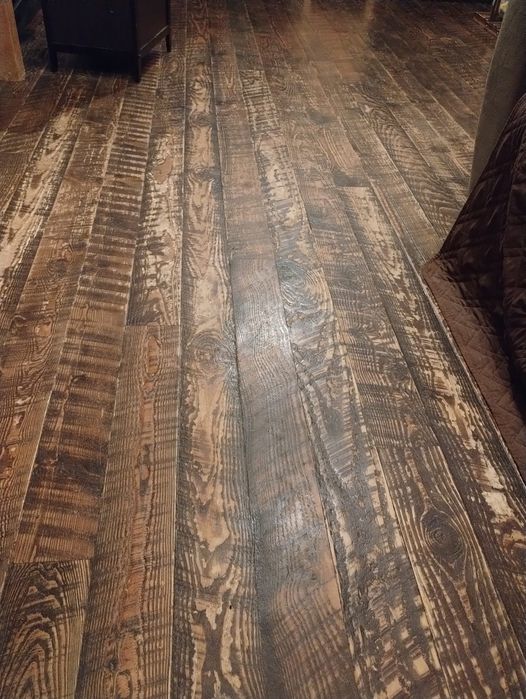How can I refinish my rough, textured floors without sanding them down and losing their unique beauty?
1 year ago
Last Updated: May 16, 2024
I have these floors all over my house that have a rough and textured look. We really love them, even though you can tell they were a DIY project from the previous owners because of the bigger gaps between some of the boards.
In high-traffic areas, the top coat and stain have worn off, and you could potentially get splinters. I’m not sure what kind of sealant was used on them. I really don’t want to sand down the floors and lose that beautiful texture, but I’m not sure how to reseal them without sanding. Any suggestions on the best way to proceed?

I really like the appearance of them.
These floors are fantastic! Maybe consider adding a layer of glossy finish for an extra touch.
Sure, are you able to use polyurethane?
Suggests sticking to products recommended for floors.
I understand that it may seem like a big task, but simply lightly sanding by hand and then applying one or two coats of glossy finish can really make a difference. Your floors will look amazing!
A light sanding should preserve the natural look of the wood. I suggest going with a satin finish instead of a glossy one.
For this project, start with a light sanding, followed by cleaning, then apply gel stain and finish with polyurethane.
If you need to sand the floors, it might be a good idea to rent a walk behind vibrating sander instead of a drum sander. Just make sure to use polyurethane specifically designed for floors
I really like this flooring style, it reminds me of hand scraped wood floors. They’re beautiful
You could consider using Tung oil or a wipe on wax
Getting rid of the saw kerf texture would require extensive sanding. It’s quite noticeable. Sand it down, use a matching stain to cover the kerf marks that will still be visible after sanding. Finish it off with a product like Bona mega traffic HD or waterlox tung oil.
For most finishes, you can add another layer (or more) years later if needed. My suggestion would be to start by applying matching stain to any scratches or scuffs, then sand the entire floor with a 320 grit sanding sponge to create a good bond for the next layer. Clean everything thoroughly with a strong degreaser, and finish with another coat of compatible floor varnish. If one coat isn’t enough, you can repeat the process. Make sure to use a varnish that is compatible with the original finish, such as Bona’s catalyzed waterborne varnish. Bona products are known for their quality. Just to clarify, I’m not a professional floor finisher, but I’ve been working as a remodeler for years and have finished around a dozen floors in the last two decades.
Hey there, thanks a bunch ! I was actually just wondering if there are any floor coverings out there that are specifically designed to bond or go over other types. This info is incredibly useful.
Just a quick follow-up question. Our house is pretty busy, with a 1 year old and 3 year old running around. Would it be possible to tackle this in small sections? Or will there be a visible difference between where the finish stopped one day and started again another day?
You, if you want it to turn out well, it’s best to do the entire thing in one go. Otherwise, it’s pretty noticeable where you paused and started again
I appreciate that, I was actually concerned about that. So, is the product you mentioned earlier named bona classicseal?
Recommends using Bona’s recoat treatment for wood floors. You can find more information at: https://www.bona.com/en-us/professional/wood-flooring-contractor/recoat-treatment/
I also own a remodeling business and I completely support this approach.
Get it checked out and sealed again.
Absolutely love this!
We recently purchased Hallmark wood flooring similar to this, but in maple. It has a nu oil finish, requiring a specific cleaner and refinisher oil. When it gets worn out, buffing oil back in could be the solution. Maybe yours is just oiled?
It might be time-consuming to sand down deep enough to remove all the texture. Try using a random orbit sander to target the splintered areas first, then lightly sand everything else before recoating.
Rent a random orbit floor sander and grab some 250 grit paper to smooth out the whole floor. This will get rid of any rough spots. Opt for a lighter stain to maintain the darker pattern of the curf marks, then finish it off with either a coat of floor poly or multiple applications of tung oil.
If you prefer a non-shiny look, go with tung oil since you can easily apply more to high traffic areas without having to sand again.
For the first coat of tung oil, mix it 50/50 with mineral spirits to allow it to penetrate and nourish the wood.
Apply the next two coats very thinly by mopping on and wiping off excess. Allow several days for each coat to cure before adding the next one.
Please refrain from sanding these floors! Instead, perform a thorough cleaning followed by applying three coats of satin polyurethane. This method will effectively address the splinter issue while preserving the rough sawn texture and character.
I just want a very light sanding, so ensure a new coat adheres well. My main worry is not being aware of the current type of coating on it.
Hey, I just had to pop in and say WOW! Absolutely stunning.